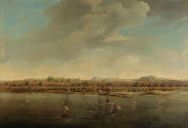A Dutch visit to the Qianlong emperor
If you are reading this story, odds are that you are sitting in a chair. The average Dutch person sits roughly nine hours a day.
In honor of the Qianlong emperor’s sixtieth year on the throne, the Dutch East India Company, or Vereenigde Oostindische Compagnie (VOC), decided to send an embassy to the Qing court. This embassy arrived in 1795 and was the third of four VOC embassies to China. It consisted of a number of Dutchmen including the Dutch VOC merchant Andreas Everardus van Braam Houckgeest (1739-1801), and the head of the embassy, Isaac Titsingh (1745-1812).
Maritime trade between Europe and China had expanded when the Portuguese started to sail east in the 16th century. The Dutch VOC, established in 1602, commercialized this trade further.
It was during this period spent in China that Van Braam Houckgeest obtained the chair you see on your screen.
](https://micrio.thingsthattalk.net/hipme/views/max/209x128.jpg)

](https://micrio.thingsthattalk.net/UTEcY/views/max/133x128.png)